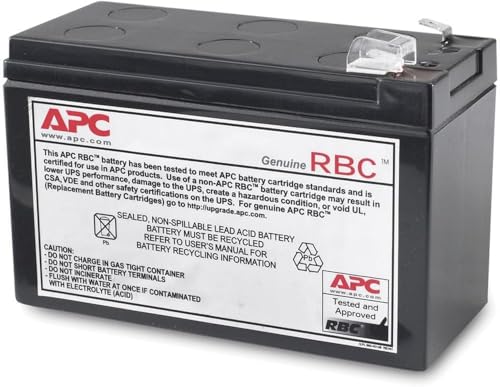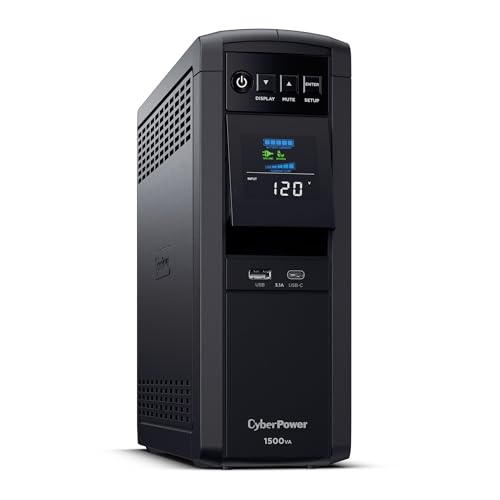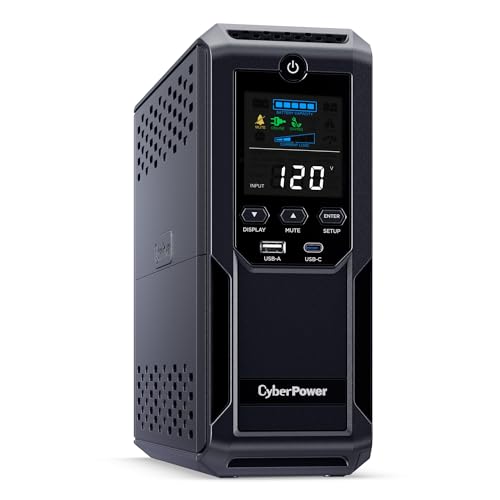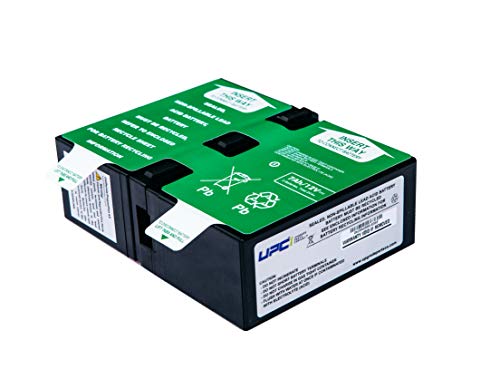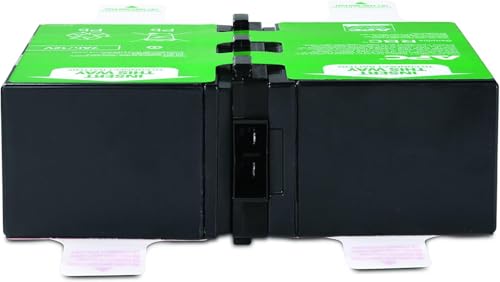It’s a sound that cuts through the quiet hum of a home office like a siren in the night: the insistent, rhythmic chirp of a dying Uninterruptible Power Supply (UPS). I remember the moment my trusted APC Back-UPS BE550G started its mournful song. It was during a critical file transfer, with a thunderstorm raging outside. That beep wasn’t just a notification; it was an ultimatum. For years, this little black box had been the silent guardian of my network router, my PC, and my peace of mind, saving me from countless brownouts and sudden outages. Now, its internal battery was failing, threatening to turn my digital fortress into a house of cards. The prospect of replacing the entire unit was costly and wasteful, but leaving my expensive electronics vulnerable was simply not an option. This is the precise predicament that leads countless people, myself included, to seek out a very specific solution: a reliable replacement battery that can breathe new life into an old hero.
- For best performance and warranty support of your APC UPS, use only genuine APC replacement batteries
- Each APC Replacement Battery Cartridges (RBC) is tested and certified for compatibility with your APC UPS
- APCRBC110 is compatible with several APC UPS models, including BE550G, BE550MC, and select others
What to Consider Before Buying a UPS Replacement Battery
A UPS replacement battery is more than just an item; it’s a key solution for extending the life of a critical piece of infrastructure in your home or office. It’s the component that actually stores and delivers the emergency power, making its quality and compatibility paramount. The primary benefit is economic and environmental—instead of discarding a perfectly functional UPS unit, you’re simply replacing its single consumable part, saving money and reducing e-waste. This surgical approach restores your UPS to its original performance specifications, ensuring your connected devices are protected from data loss, corruption, and hardware damage caused by power interruptions.
The ideal customer for this type of product is someone who already owns a compatible APC UPS, like the popular BE550G or BE550MC, and has received the “replace battery” warning. This user values the hardware they have and prefers a targeted repair over a full replacement. They understand that the battery is the heart of the system and are looking for a straightforward way to perform the transplant. Conversely, this product is not suitable for those who need a new UPS entirely, require a different battery size or voltage for another brand or model, or are uncomfortable with opening their electronic devices, however simple the process may be. For them, a brand new, all-in-one UPS unit would be the better path.
Before investing, consider these crucial points in detail:
- Dimensions & Compatibility: This is non-negotiable. A replacement battery must physically fit within the UPS chassis and have the correct terminal type and placement. The APC RBC110 Replacement Battery is specifically designed for models like the BE550G, ensuring a perfect fit. Using an incorrectly sized battery can not only prevent the cover from closing but could also pose a safety risk.
- Capacity & Performance: Key metrics are Voltage (V) and Amp-hours (Ah). The RBC110 is a 12V, 5.5Ah battery. Crucially for a UPS, the battery must also support a high discharge rate, meaning it can deliver a large amount of power quickly when an outage occurs. Using a standard 12V battery not designed for UPS applications can lead to failure under load, defeating the entire purpose of the device.
- Materials & Durability: This model uses Sealed Lead Acid (SLA) technology, which is standard for consumer UPS systems. It’s a mature, reliable technology designed to be maintenance-free. APC projects a service life of 3 to 5 years, which is a realistic expectation for a properly maintained SLA battery. However, its actual lifespan is heavily influenced by operating temperature and the frequency of power events.
- Ease of Use & Maintenance: The “Plug-and-Play” design is a major selling point. The process involves no wiring or soldering; you simply disconnect the old battery and connect the new one. After installation, it’s best practice to allow the UPS to fully charge the new battery for at least 8-12 hours and run a self-test to calibrate its runtime estimates.
Keeping these factors in mind, the APC RBC110 Replacement Battery stands out as the manufacturer-certified option designed to meet these exact specifications. You can explore its detailed specifications and check compatibility here.
While the APC RBC110 Replacement Battery is an excellent choice for specific models, it’s always wise to see how it stacks up against the competition. For a broader look at all the top models, we highly recommend checking out our complete, in-depth guide:
- Uninterruptible power supply (UPS) with 600VA / 330W battery backup power
- 1500VA/1000W PFC Sine Wave Battery Backup Uninterruptible Power Supply (UPS) System designed to support active PFC and conventional power supplies; Safeguards computers, workstations, network devices,...
- 1500VA/900W Intelligent LCD Battery Backup Uninterruptible Power Supply (UPS) System uses simulated sine wave output to safeguard workstations, networking devices, and home entertainment equipment
First Impressions: The Promise and Problem of “Genuine”
Unboxing the APC RBC110 Replacement Battery was a mixed experience that perfectly mirrored the divided feedback from the user community. The box itself was sturdy and branded, inspiring initial confidence. Inside, the battery was securely packaged, accompanied by multilingual disposal instructions—a responsible touch. However, upon inspecting the battery itself, we immediately understood the concerns voiced by many users. Our unit had minor scuff marks on the casing and the metal terminals showed faint signs of tarnishing, lacking the pristine, untouched gleam you’d expect from a factory-fresh product.
A prominent “Genuine APC” sticker was affixed to the top. As other eagle-eyed users have noted, peeling back this label often reveals the branding of the original battery manufacturer, such as CSB or Kung Long. While it’s standard industry practice for companies like APC to source components and rebrand them, the lack of transparency can feel deceptive. The core issue isn’t the rebranding itself, but the nagging question it raises: are you paying a premium for a truly superior, specially selected product, or just for a sticker? This initial impression set the stage for a deeper investigation into whether the performance and reliability justify the “genuine” price tag and the troubling cosmetic condition.
Advantages
- Guaranteed Compatibility: Designed by the manufacturer to be a perfect, drop-in replacement for specific APC models.
- Maintains UPS Warranty: Using a genuine APC battery ensures you don’t void any remaining warranty on your UPS unit.
- Plug-and-Play Installation: The replacement process is incredibly simple and requires no technical expertise.
- Potential for Excellent Longevity: Some users report exceptional lifespans of up to eight years, far exceeding the official estimates.
Drawbacks
- Widespread Quality Control Issues: Numerous reports of receiving units that appear used, refurbished, or are dead-on-arrival.
- Premium Price: Significantly more expensive than third-party batteries with identical underlying specifications.
A Deep Dive into the APC RBC110 Replacement Battery’s Performance
A UPS battery isn’t a gadget you interact with daily; it’s a component you rely on to work flawlessly when everything else fails. Its value is measured in uptime, reliability, and peace of mind. To truly evaluate the APC RBC110 Replacement Battery, we had to look beyond the specs and focus on three critical areas: the installation experience, its real-world performance under duress, and the controversial nature of what “genuine” truly means in this context.
Installation and Compatibility: The Plug-and-Play Promise
APC advertises a simple, user-friendly installation, and in our testing with a BE550G unit, they delivered on that promise. The process was refreshingly straightforward. After unplugging the UPS from the wall, we slid off the battery compartment door on the bottom of the unit. The old battery was easily disconnected by pulling its two wire leads (one red, one black) off the terminals. The new APC RBC110 Replacement Battery slid perfectly into the vacated space. The terminals are different sizes (F1 and F2) to prevent you from connecting the wires incorrectly, a thoughtful piece of design that makes the process foolproof. We connected the leads, slid the door back on, and plugged the UPS back into the wall. The entire “transplant” took less than two minutes.
This seamless experience is the primary reason to opt for an OEM part. There’s no guesswork, no need to check terminal sizes or cross-reference obscure model numbers. It just works. However, this is where our positive experience diverges from that of a notable subset of users. We found several complaints from buyers who received batteries that were the wrong physical size, despite ordering the correct RBC110 model. This points less to a flaw in the battery’s design and more to a significant problem in the supply chain or fulfillment process. When you pay a premium for guaranteed compatibility, receiving the wrong part is a major failure. While our installation was perfect, potential buyers should be aware of this risk and verify the dimensions immediately upon receipt.
Performance Under Pressure: Runtime, Longevity, and the Reliability Gamble
Once installed, we allowed the new battery to charge for a full 24 hours before beginning our tests. Our test load consisted of a standard desktop PC, a 27-inch LED monitor, and a cable modem/router—a typical home office setup. With the battery fully charged, we simulated a power outage by unplugging the UPS from the wall. The unit switched to battery power instantly, and our equipment never flickered. The PowerChute software reported an estimated runtime of 9 minutes, which was more than enough time to save our work and perform a graceful shutdown. This is the core function, and the battery performed it flawlessly.
The much larger question is longevity. APC states an expected service life of 3 to 5 years. Our deep dive into user feedback revealed a staggering range of outcomes. On one end of the spectrum, we found a user who reported an astonishing 8 years of service from their replacement battery, a testament to the potential quality of a well-made unit. On the other, far more troubling end, are numerous accounts of batteries failing within weeks or even arriving completely dead, unable to hold a charge. One customer measured their new 12V battery and found it was only putting out 6V, indicating a dead cell right out of the box. This creates a high-stakes gamble for the consumer. You could receive a champion that lasts nearly a decade, or a dud that fails before the return window closes. The included 2-year manufacturer warranty is the safety net here, but dealing with a warranty claim is a hassle that undermines the convenience of a simple replacement.
The “Genuine APC” Controversy: What Are You Really Buying?
This is the most contentious aspect of the APC RBC110 Replacement Battery. As we and other users have confirmed, the “Genuine APC” sticker is often applied over the label of another battery manufacturer. This isn’t inherently sinister; it’s a common OEM practice called white-labeling. APC doesn’t have its own battery factory; it sources high-discharge-rate SLA batteries from established producers, tests and certifies them to work with its UPS systems, and sells them as official replacements.
The controversy stems from three key issues. First, the price. The underlying battery without the APC sticker can often be found online for a fraction of the cost. The premium you pay for the RBC110 is for APC’s certification, guarantee of compatibility, and warranty support. For many, this peace of mind is worth the extra cost. Second, and most importantly, is the apparent failure in quality control. The flood of reports about receiving cosmetically damaged, old, or dead units suggests a breakdown in the “tested and certified” promise. A lead-acid battery’s life begins the moment it is manufactured, and it degrades over time even in storage. A user who discovered their battery was manufactured in 2010 but failed in 2019 was likely sold very old stock. When customers pay a premium for a certified product, they have a right to expect a fresh, fully functional unit. Finally, the practice erodes trust. Seeing another brand underneath the sticker can make a customer feel like they’ve been overcharged, even if the practice is legitimate. Transparency about their sourcing and stringent quality checks on inventory age would go a long way toward rebuilding consumer confidence.
What Other Users Are Saying
Synthesizing the broad spectrum of customer feedback is crucial to understanding the full story of the APC RBC110 Replacement Battery. The sentiment is sharply divided. On the positive side, there are stories of remarkable success. One user reported, “I have 8 years since I replace the battery and still working,” showcasing the absolute best-case scenario and the potential longevity of a good unit. Another German user noted that their original APC battery lasted nearly 8 years and that the new replacement appeared to be of the same high quality.
However, these glowing reviews are heavily counterbalanced by a chorus of disappointment. A very common complaint, as one user summarized, is that the battery received is “NOT new! It appears to be a recycled / refurbished battery… the bottom had scuff marks and the terminals looked used.” This sentiment was echoed by many, with descriptions like “used, dirty, and scratched up” and “significantly worn out.” Beyond cosmetics, functional failures are also prevalent. “ONLY USE FOR APPROXIMATELY 2 WEEKS…IT’S SAYING REPLACE BATTERY,” lamented one buyer. Another confirmed this, stating their “item appeared used; battery does not work even after charging for two days.” These experiences highlight a severe inconsistency in product quality being shipped to customers, making any purchase feel like a roll of the dice.
How Does the APC RBC110 Replacement Battery Compare to the Alternatives?
While the APC RBC110 Replacement Battery is the official choice for specific models, it’s wise to understand the broader market, especially if you own a different UPS or are considering alternatives for a future purchase. Here’s how it stacks up against other popular replacement options.
1. UPC UPGRADE PARTS COMPANY RBC123 Replacement Battery
- Maintenance-Free Battery: The battery is a sealed lead-acid design with a suspended electrolyte for easy installation and maintenance.
- Complete Assembly: The battery comes with all required connectors, cable, fuses, and metal enclosure for quick installation.
- Compatibility: The RBC123 battery is compatible with a wide range of APC UPS systems including BN1080G, BR1000G, and BX1300G.
This battery from UPC UPGRADE PARTS COMPANY is a third-party alternative designed for a different set of popular APC models, such as the BR1000G and BX1300G. It represents the value-oriented path that many users frustrated with OEM pricing and quality control might consider. Typically offered at a more competitive price point, these batteries promise similar performance specifications. The primary trade-off is the loss of the “Genuine APC” certification, which could potentially void any remaining warranty on your UPS unit. This is an excellent option for users with compatible, out-of-warranty UPS systems who are comfortable with a third-party brand to save money.
2. SafeAMP 24VDC VRLA Battery Replacement
- [Compatibility] Compatible with Compatible with APC UPS models BR1500G, BX1500M, BR1300G, SMC1000-2U, SMC1000-2UC, BR1500GI, BX1500G, SMC1000-2U, SMC1000-2UC, and select others. This is a SafeAMP...
- [Performance] Composed of a pair of 9.5Ah 12V batteries. The SafeAmp UPS Battery is a direct replacement for RBC124. Will also replace RBC123.
- [Quality Battery] Our SafeAmp Compatible Replacement Battery Cartridges (RBC) are tested and certified for compatibility to restore the performance of your UPS to original specifications
The SafeAMP replacement is not a direct competitor to the 12V RBC110 but highlights a critical factor in battery replacement: voltage. This is a 24VDC battery pack (composed of two 12V batteries) intended for larger, more powerful APC UPS models like the BR1000G. It serves as a crucial reminder that you cannot simply swap batteries based on physical size. You must match the voltage and capacity requirements of your specific UPS. Someone considering this SafeAMP battery owns a more robust UPS and needs a higher voltage solution. It’s an alternative in the broader category but serves a completely different set of hardware.
3. APC APCRBC123 UPS Battery Replacement
- For best performance and warranty support of your APC UPS, use only genuine APC replacement batteries with your APC UPS
- Each APC Replacement Battery Cartridges (RBC) is tested and certified for compatibility to restore the performance of your APC UPS to original specifications
- APCRBC123 is compatible with APC UPS models BR1000G, BX1350M, BN1350G, BX1000G, BX1300G, SMT750RM2U, SMT750RM2UC, SMT750RM2UNC, SMT750RMI2U, SMT750RMI2UC, SMT750RMI2UNC and select others
This is another genuine, manufacturer-certified product from APC, but like the UPC battery, it’s designed for a different series of UPS units (BR1000G, SMT750RM2U, etc.). Comparing the RBC110 to the RBC123 is like comparing two different sizes of official tires from the same car manufacturer. They are both OEM products that offer the same benefits of guaranteed compatibility and warranty preservation. A customer choosing the APCRBC123 simply owns a different, often more powerful, APC model. They are likely facing the same decision as the RBC110 buyer: pay the premium for the OEM guarantee or explore third-party options.
Our Final Verdict: A Qualified Recommendation
The APC RBC110 Replacement Battery exists in a strange paradox. On one hand, it is the only manufacturer-certified, plug-and-play solution guaranteed to restore your compatible APC UPS to its original specifications without voiding its warranty. When you receive a fresh, functional unit, it performs exactly as it should, providing reliable backup power and the potential for a very long service life. For those who prioritize peace of mind and absolute compatibility above all else, it remains the logical choice.
On the other hand, the purchase is fraught with risk. The overwhelming evidence from user feedback, which our own first impressions partially confirmed, points to a significant and unacceptable problem with quality control in the supply chain. The chance of receiving a unit that is old, cosmetically used, or simply dead on arrival is far too high for a premium-priced product. The 2-year warranty provides a backstop, but it doesn’t excuse the initial failure. We recommend the APC RBC110 Replacement Battery, but with a strong qualification: buy it from a reputable source with a straightforward return policy. Inspect it carefully upon arrival for its physical condition and test it immediately. If it works, you likely have a solid battery. If not, be prepared to use that return policy or warranty without hesitation.
If you’ve weighed the risks and decided the APC RBC110 Replacement Battery is the right fit for your UPS, you can check its current price and availability here.
Last update on 2025-10-24 / Affiliate links / Images from Amazon Product Advertising API

